
FM 21-150 COMBATIVES 1992
.pdf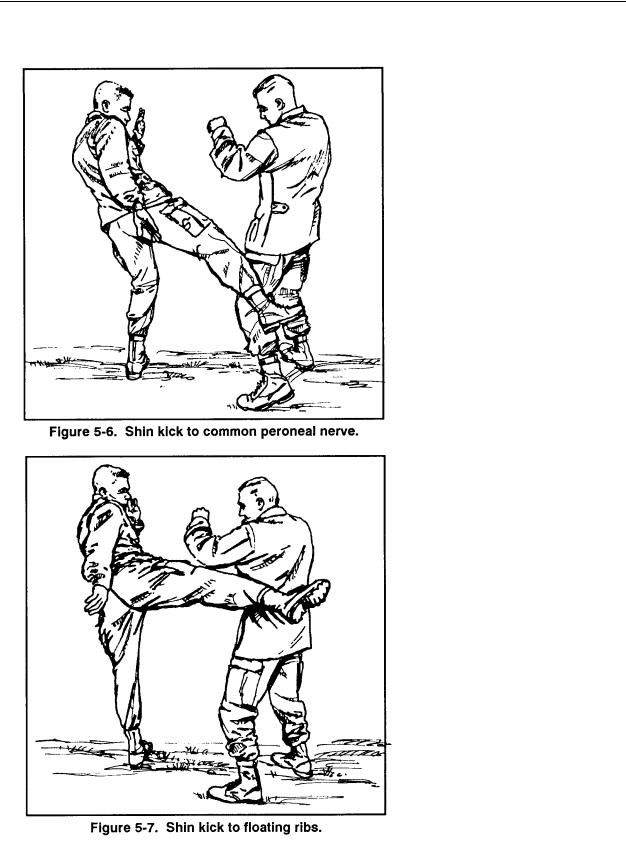
FM 21-150
The calves and common peroneal nerve (Figure 5-6) are the best striking points.
The shin kick can also be used to attack the floating ribs (Figure 5-7).
5-8
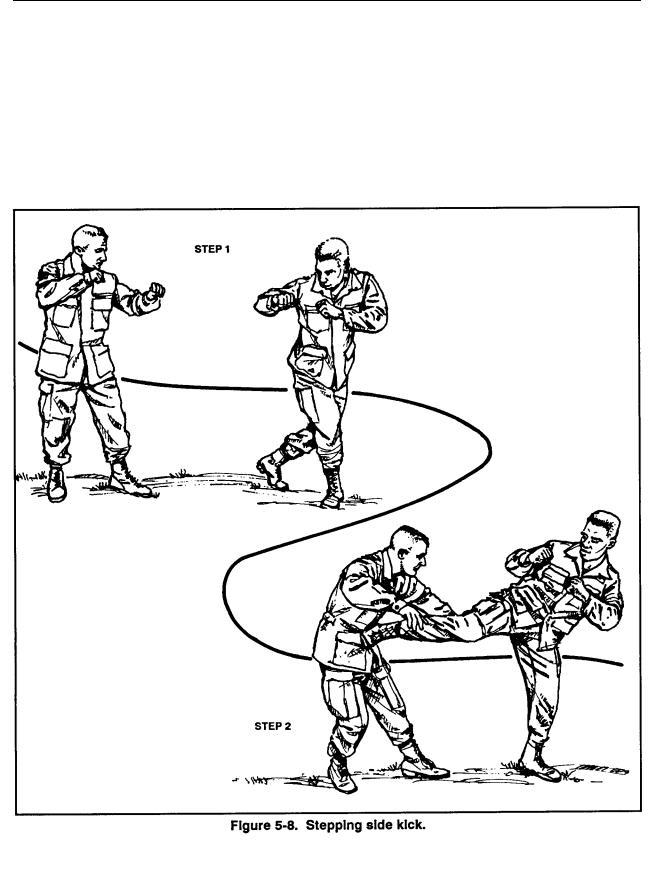
FM 21-150
f. Stepping Side Kick. A soldier starts a stepping side kick (Figure 5-8, Step 1) by stepping either behind or in front of his other foot to close the distance between him and his opponent. The movement is like that in a skip.
The soldier now brings the knee of his kicking foot up and thrusts out a side kick (Figure 5-8, Step 2). Tremendous power and momentum can be developed in this kick.
5-9

FM 21-150
g. Counter to Front Kick. When the attacker tries a front kick, the defender traps the kicking foot by meeting it with his own (Figure 5-9, Step 1). The defender turns his foot 45 degrees outward to increase the likelihood of striking the opponent’s kicking foot. This counter requires good timing by the defender, but not necessarily speed. Do not look at the feet; use your peripheral vision.
When an attacker tries a front kick (Figure 5-9, Step 2), the defender steps off the line of attack of the incoming foot to the outside.
As the attacker’s kicking leg begins to drop, the defender kicks upward into the calf of the attacker’s leg (Figure 5-9, Step 3). This kick is extremely painful and will probably render the leg ineffective. This technique does not rely on the defender’s speed, but on proper timing.
The defender can also kick to an opponent’s kicking leg by moving off the line of attack to the inside and by using the heel kick to the inside of the thigh or groin (Figure 5-9, Step 4).
5-10
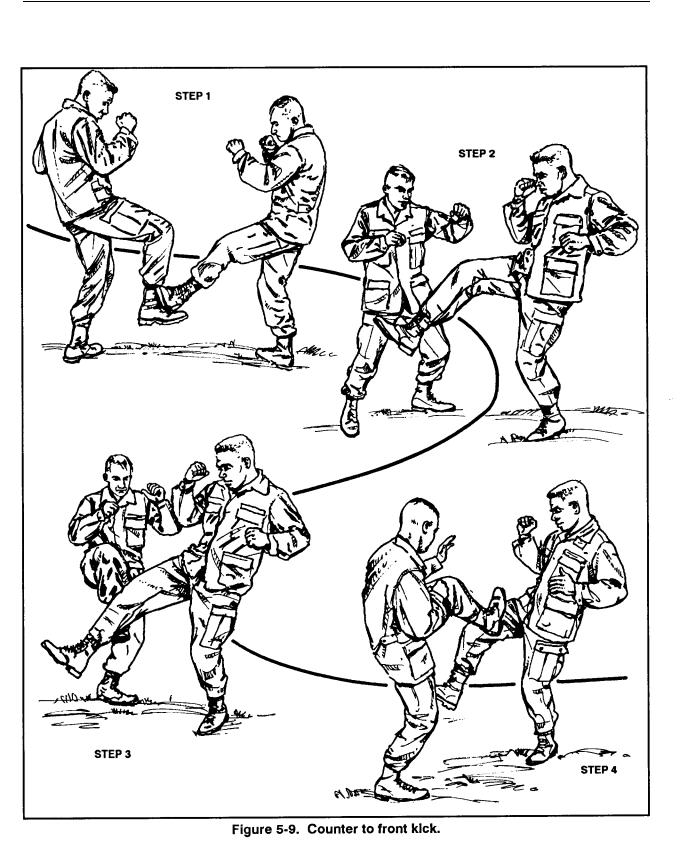
FM 21-150
5-11

FM 21-150
h. Counter to Roundhouse-Type Kick. When an opponent prepares to attack with a roundhouse-type kick (Figure 5-10, Step 1), the defender moves off the line of attack by stepping to the inside of the knee of the kicking leg.
He then turns his body to receive the momentum of the leg (Figure 5-10, Step 2). By moving to the inside of the knee, the defender lessens the power of the attacker’s kicking leg. The harder the attacker kicks, the more likely he is to hyperextend his own knee against the body of the defender, but the defender will not be harmed. However, the defender must get to the inside of the knee, or an experienced opponent can change his roundhouse kick into a knee strike. The defender receives the energy of the kicking leg and continues turning with the momentum of the kick.
The attacker will be taken down by the defender’s other leg with no effort (Figure 5-10, Step 3).
5-12

FM 21-150
5-13
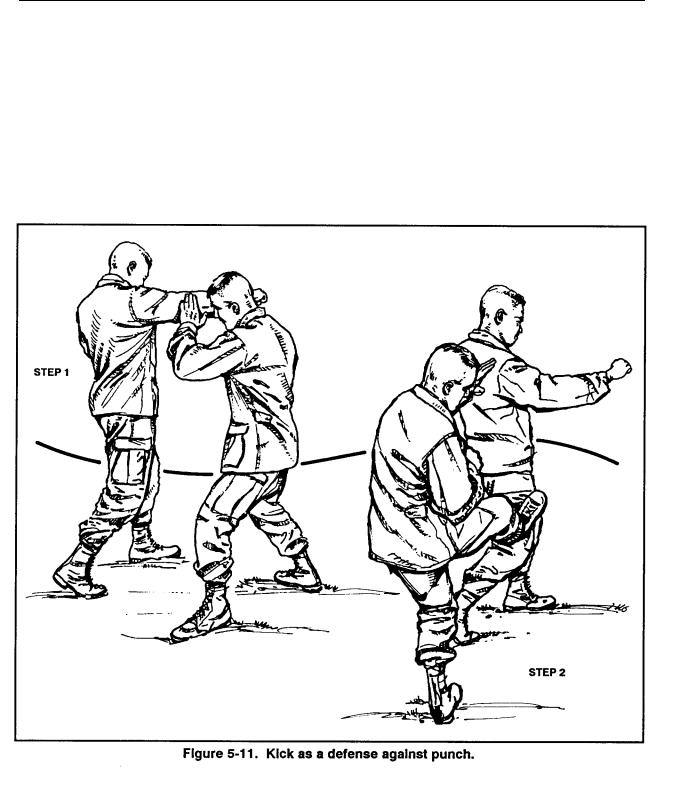
FM 21-150
i. Kick as a Defense Against Punch. As the opponent on the left throws a punch (Figure 5-11, Step 1), the defender steps off the line of attack to the outside.
He then turns toward the opponent, brings his knee to his chest, and launches a heel kick to the outside of the opponent’s thigh (Figure 5-11, Step 2). He keeps his foot turned 45 degrees to ensure striking the target and to maintain balance.
5-14

FM 21-150
Section II
DEFENSIVE TECHNIQUES
A knife (or bayonet), properly employed, is a deadly weapon; however, using defensive techniques, such as maintaining separation, will greatly enhance the soldier’s ability to fight and win.
5-3. DEFENSE AGAINST AN ARMED OPPONENT
An unarmed defender is always at a distinct disadvantage facing an armed opponent. It is imperative therefore that the unarmed defender understand and use the following principles to survive:
a. Separation. Maintain a separation of at least 10 feet plus the length of the weapon from the attacker. This distance gives the defender time to react to any attempt by the attacker to close the gap and be upon the defender. The defender should also try to place stationary objects between himself and the attacker.
b. Unarmed Defense. Unarmed defense against an armed opponent should be a last resort. If it is necessary, the defender’s course of action includes:
(1)Move the body out of the line of attack of the weapon. Step off the line of attack or redirect the attack of the weapon so that it clears the body.
(2)Control the weapon. Maintain control of the attacking arm by securing the weapon, hand, wrist, elbow, or arm by using joint locks, if possible.
(3)Stun the attacker with an effective counterattack. Counterattack should be swift and devastating. Take the vigor out of the attacker with a low,
unexpected kick, or break a locked joint of the attacking arm. Strikes to motor nerve centers are effective stuns, as are skin tearing, eye gouging, and attacking of the throat. The defender can also take away the attacker’s balance.
(4)Ground the attacker. Take the attacker to the ground where the defender can continue to disarm or further disable him.
(5)Disarm the attacker. Break the attacker’s locked joints. Use leverage or induce pain to disarm the attacker and finish him or to maintain physical control.
c.Precaution. Do not focus full attention on the weapon because the attacker has other body weapons to use. There may even be other attackers that you have not seen.
d.Expedient Aids. Anything available can become an expedient aid to defend against an armed attack. The kevlar helmet can be used as a shield; similarly, the LCE and shirt jacket can be used to protect the defender against a weapon. The defender can also throw dirt in the attacker’s eyes as a distraction.
5-15
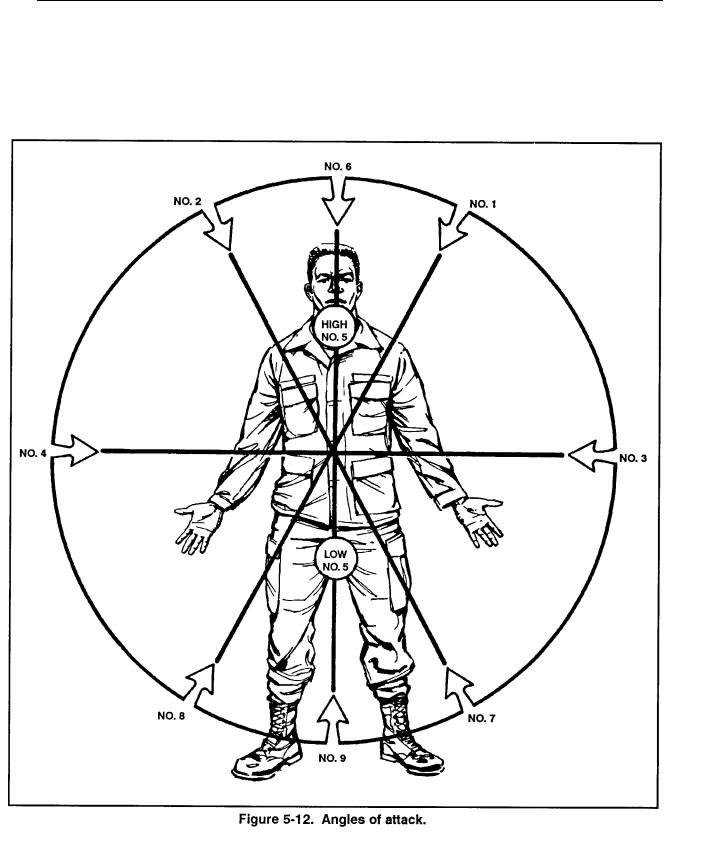
FM 21-150
5-4. ANGLES OF ATTACK
Any attack, regardless of the type weapon, can be directed along one of nine angles (Figure 5-12). The defense must be oriented for each angle of attack.
5-16

FM 21-150
a.No. 1 Angle of Attack. A downward diagonal slash, stab, or strike toward the left side of the defender’s head, neck, or torso.
b.No. 2 Angle of Attack. A downward diagonal slash, stab, or strike toward the right side of the defender’s head, neck, or torso.
c.No. 3 Angle of Attack A horizontal attack to the left side of the defender’s torso in the ribs, side, or hip region.
d.No. 4 Angle of Attack. The same as No. 3 angle, but to the right side.
e.No. 5 Angle of Attack. A jabbing, lunging, or punching attack directed straight toward the defender’s front.
f.No. 6 Angle of Attack.An attack directed straight down upon the defender.
g.No. 7 Angle of Attack. An upward diagonal attack toward the defender’s lower-left side.
h.No. 8 Angle of Attack. An upward diagonal attack toward the defender’s lower-right side.
i.No. 9 Angle of Attack. An attack directed straight up—for example, to the defender’s groin.
5-5. DEFENSE AGAINST A KNIFE
When an unarmed soldier is faced with an enemy armed with a knife, he must be mentally prepared to be cut. The likelihood of being cut severely is less if the fighter is well trained in knife defense and if the principles of weapon defense are followed. A slash wound is not usually lethal or shock inducing; however, a stab wound risks injury to vital organs, arteries, and veins and may also cause instant shock or unconsciousness.
a. Types of Knife Attacks. The first line of defense against an opponent armed with a knife is to avoid close contact. The different types of knife attacks follow:
(1)Thrust. The thrust is the most common and most dangerous type of knife attack. It is a strike directed straight into the target by jabbing or lunging.
(2)Slash. The slash is a sweeping surface cut or circular slash. The wound is usually a long cut, varying from a slight surface cut to a deep gash.
(3)Flick. This attack is delivered by flicking the wrist and knife to extended limbs, inflicting numerous cuts. The flick is very distractive to the defender since he is bleeding from several cuts if the attacker is successful.
(4)Tear. The tear is a cut made by dragging the tip of the blade across the body to create a ripping-type cut.
(5)Hack. The hack is delivered by using the knife to block or chop with.
(6)Butt. The butt is a strike with the knife handle.
5-17
